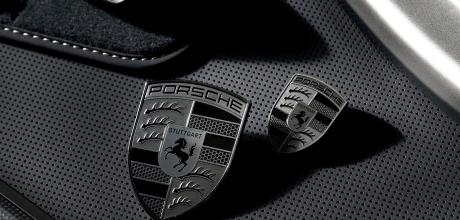Porsche introduces monotone badging for its new turbo cars
For almost fifty years, Turbo-badged cars have enjoyed an exalted position at Porsche. They stand for high performance and represent the epitome of every model series. Of course, this is only true if you forget about the existence of Turbo S models. And the manufacturer’s GT products. Porsche isn’t one to let fact get in the way of a good story, so let’s play along and assume things are as they were in the late 1970s and early 1980s, when a Turbo badge meant the car you were driving sat at the very top of the brand’s model hierarchy. Unlike today, it also meant your Porsche carried a turbocharger.
To give new Turbo models greater prominence in a crowded car park, fresh exterior badging has been developed and will be rolled out across all new Turbo models with immediate effect. The modernised crest is dominated by a ‘colour’ Porsche describes as Turbonite, which replaces the gold, red and black seen on Porsche crests up until this point in time. Confusingly, the manufacturer’s marketing department, which is causing eyebrows to raise with a string of somewhat bizarre press releases and questionable celebrity tie-ins intended to help shift Taycans at a time dealers are complaining of overproduction and stock not shifting, released photographs of the new badging in a selection of greyscale images, leading many to wonder just how much of the Porsche crest has been altered. We managed to get our grubby mitts on images of the new Panamera Turbo E-Hybrid Sonderwunsch, a one-off build designed to demonstrate the possibilities of the manufacturer’s Porsche Exclusive Manufaktur department to Chinese buyers. The unique ‘more door’ wears the new Turbo badge. As you can see, all colour is removed.
“In 1974, Porsche presented the first turbocharged 911,” says Michael Mauer, Vice President of Style Porsche. “Since then, Turbo has become a synonym for our high-performance top models and is now more or less a brand in its own right.” This is his way of explaining why Turbo is now applied to Porsche products as a kind of trim identifier, rather than the host Porsche making use of forced induction or, in fact, a combustion engine. “We want to make Turbo models even more visible and differentiate them more markedly from other derivatives, such as GTS models. This is why we’ve developed a distinctive new Turbo aesthetic. From now on, our Turbo products will exhibit a consistent appearance across all model series.”
GREY MATTERS
Turbo model rear badge lettering, as well as window borders and steering wheel decoration, will also be subjected to Turbonite. Depending on model series, further details, such as wheel spokes and inlays in the front aprons “could” also feature Turbonite. Additionally, selected components in the interior, including trim strips, belt straps and various controls, such as the driving mode switch and buttons on the airconditioning control panel, will also be finished in this understated hue. Will we see owners of existing Turbo models engaging in Turbonite badge engineering, thereby ‘forward dating’ their cars? Probably — these badges look great on black Porsches. Enter a new trend for 2024.


